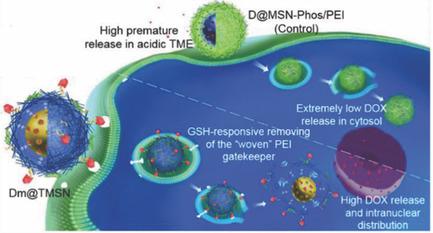当前位置:
X-MOL 学术
›
Adv. Funct. Mater.
›
论文详情
Our official English website, www.x-mol.net, welcomes your feedback! (Note: you will need to create a separate account there.)
Integrated Combination Treatment Using a “Smart” Chemotherapy and MicroRNA Delivery System Improves Outcomes in an Orthotopic Colorectal Cancer Model
Advanced Functional Materials ( IF 19.0 ) Pub Date : 2018-04-30 , DOI: 10.1002/adfm.201801118 Hai-Jun Liu 1 , Xin Luan 1 , Hai-Yi Feng 1 , Xiao Dong 1 , Si-Cong Yang 1 , Zhong-Jian Chen 1 , Qin-Yi Cai 1 , Qin Lu 1 , Yunpeng Zhang 2 , Peng Sun 2 , Mei Zhao 3 , Hong-Zhuan Chen 1 , Jonathan F. Lovell 4 , Chao Fang 1
Advanced Functional Materials ( IF 19.0 ) Pub Date : 2018-04-30 , DOI: 10.1002/adfm.201801118 Hai-Jun Liu 1 , Xin Luan 1 , Hai-Yi Feng 1 , Xiao Dong 1 , Si-Cong Yang 1 , Zhong-Jian Chen 1 , Qin-Yi Cai 1 , Qin Lu 1 , Yunpeng Zhang 2 , Peng Sun 2 , Mei Zhao 3 , Hong-Zhuan Chen 1 , Jonathan F. Lovell 4 , Chao Fang 1
Affiliation

|
Mesoporous silica nanoparticles (MSN) can load and deliver potentially synergistic anticancer agents such as small molecule cytotoxics (like doxorubicin, DOX) and nucleic acids (like microRNA, miRNA). However, these cargos have different underlying chemical properties so overcoming respective intracellular delivery barriers is a key consideration. Strategies to deliver DOX from MSN frequently employ pH‐driven mechanisms that are restricted to the acidic environment of lysosomes. Conversely, strategies to deliver miRNA make use of approaches that deliberately compromise lysosomal membrane integrity to enable cytosolic delivery of the payload. To reconcile these two needs (lysosomal delivery of DOX and intracellular delivery of miRNA), a new methodology by “weaving” polyethylenimine on the MSN surface through disulfide bonds to achieve superior delivery of chemotherapy (DOX) and miRNA therapy (using miRNA‐145) is developed. Furthermore, an active targeting strategy based on a peptide ligand with affinity to glucose‐regulated protein 78 (GRP78), a cell surface protein overexpressed in colorectal carcinoma, is developed. The active targeting approach results in enhanced synergistic antitumor effect both in vitro and in vivo in an orthotopic murine model of colorectal cancer. Taken together, this work demonstrates the capability and advantages of “smart” MSN delivery systems to deliver anticancer cargo appropriately to targeted cancer cells.
中文翻译:

使用“智能”化学疗法和MicroRNA递送系统的综合联合治疗可改善原位结直肠癌模型的结果
介孔二氧化硅纳米粒子(MSN)可以负载和传递潜在的协同抗癌剂,例如小分子细胞毒素(如阿霉素,DOX)和核酸(如microRNA,miRNA)。然而,这些货物具有不同的基本化学性质,因此克服各自的细胞内递送障碍是关键考虑因素。从MSN传递DOX的策略通常采用pH驱动机制,该机制仅限于溶酶体的酸性环境。相反,传递miRNA的策略则利用故意破坏溶酶体膜完整性的方法来实现有效载荷的胞质传递。为了调和这两个需求(溶酶体递送DOX和细胞内递送miRNA),开发了一种新方法,即通过二硫键将聚乙烯亚胺“编织”在MSN表面上,以实现化学疗法(DOX)和miRNA治疗(使用miRNA-145)的卓越递送。此外,基于与葡萄糖调节蛋白78(GRP78)有亲和力的肽配体开发了一种主动靶向策略,GRP78是在结肠直肠癌中过度表达的细胞表面蛋白。主动靶向方法在大肠癌的原位鼠模型中在体内和体外均产生增强的协同抗肿瘤作用。综上所述,这项工作证明了“智能” MSN递送系统将抗癌药适当地递送至目标癌细胞的能力和优势。基于对葡萄糖调节蛋白78(GRP78)有亲和力的肽配体,开发了一种主动靶向策略,葡萄糖调节蛋白78是在结直肠癌中过度表达的细胞表面蛋白。主动靶向方法在大肠癌的原位鼠模型中在体内和体外均产生增强的协同抗肿瘤作用。综上所述,这项工作证明了“智能” MSN递送系统将抗癌药适当地递送至目标癌细胞的能力和优势。基于对葡萄糖调节蛋白78(GRP78)有亲和力的肽配体,开发了一种主动靶向策略,葡萄糖调节蛋白78是在结直肠癌中过度表达的细胞表面蛋白。主动靶向方法在大肠癌的原位鼠模型中在体内和体外都产生增强的协同抗肿瘤作用。综上所述,这项工作证明了“智能” MSN递送系统将抗癌药适当地递送至目标癌细胞的能力和优势。
更新日期:2018-04-30
中文翻译:

使用“智能”化学疗法和MicroRNA递送系统的综合联合治疗可改善原位结直肠癌模型的结果
介孔二氧化硅纳米粒子(MSN)可以负载和传递潜在的协同抗癌剂,例如小分子细胞毒素(如阿霉素,DOX)和核酸(如microRNA,miRNA)。然而,这些货物具有不同的基本化学性质,因此克服各自的细胞内递送障碍是关键考虑因素。从MSN传递DOX的策略通常采用pH驱动机制,该机制仅限于溶酶体的酸性环境。相反,传递miRNA的策略则利用故意破坏溶酶体膜完整性的方法来实现有效载荷的胞质传递。为了调和这两个需求(溶酶体递送DOX和细胞内递送miRNA),开发了一种新方法,即通过二硫键将聚乙烯亚胺“编织”在MSN表面上,以实现化学疗法(DOX)和miRNA治疗(使用miRNA-145)的卓越递送。此外,基于与葡萄糖调节蛋白78(GRP78)有亲和力的肽配体开发了一种主动靶向策略,GRP78是在结肠直肠癌中过度表达的细胞表面蛋白。主动靶向方法在大肠癌的原位鼠模型中在体内和体外均产生增强的协同抗肿瘤作用。综上所述,这项工作证明了“智能” MSN递送系统将抗癌药适当地递送至目标癌细胞的能力和优势。基于对葡萄糖调节蛋白78(GRP78)有亲和力的肽配体,开发了一种主动靶向策略,葡萄糖调节蛋白78是在结直肠癌中过度表达的细胞表面蛋白。主动靶向方法在大肠癌的原位鼠模型中在体内和体外均产生增强的协同抗肿瘤作用。综上所述,这项工作证明了“智能” MSN递送系统将抗癌药适当地递送至目标癌细胞的能力和优势。基于对葡萄糖调节蛋白78(GRP78)有亲和力的肽配体,开发了一种主动靶向策略,葡萄糖调节蛋白78是在结直肠癌中过度表达的细胞表面蛋白。主动靶向方法在大肠癌的原位鼠模型中在体内和体外都产生增强的协同抗肿瘤作用。综上所述,这项工作证明了“智能” MSN递送系统将抗癌药适当地递送至目标癌细胞的能力和优势。



























 京公网安备 11010802027423号
京公网安备 11010802027423号